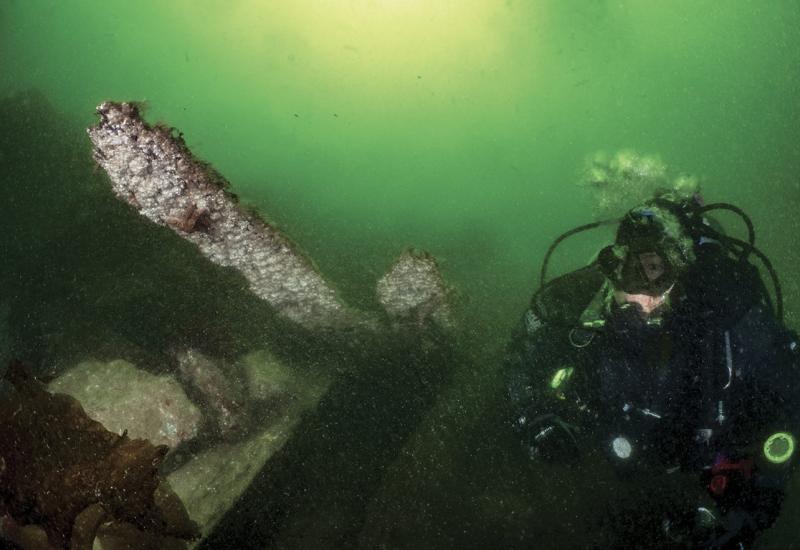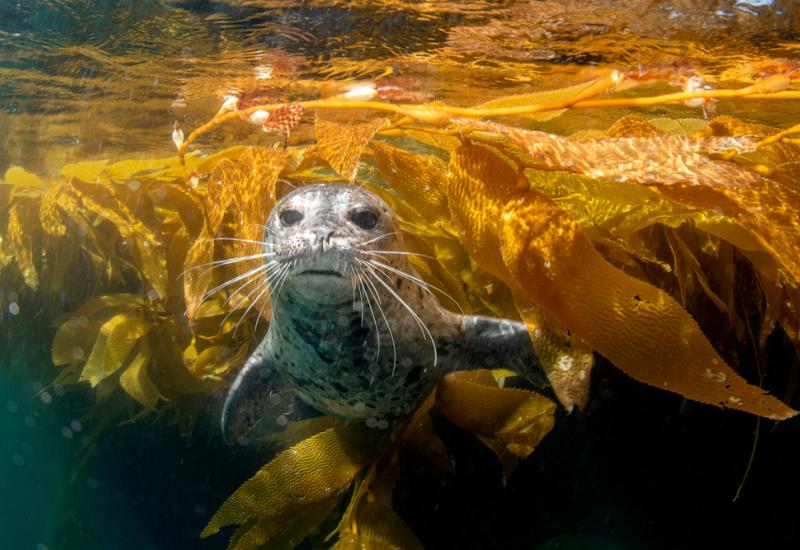Scuba Diving Newfoundland and Eastern Canada
You are reading "Part Two - Scuba Diving Newfoundland and Eastern Canada" in Jill Heinerth's five-part, underwater Canada series. Read the entire series here.
When you visit the Maritimes region of Atlantic Canada, you are likely to meet your new family. Just ask the fortuitous visitors whose planes diverted to Gander, Newfoundland, after the attacks of 9/11. They discovered that the generosity and kindness of eastern Canadians is unequaled. A popular stage play called “Come from Away” is based on the experiences of that fateful day. Once you have been a part of a Maritime kitchen party, you’ll agree.

Jill HeinerthRenee Power looks at the beautiful anemones in the location where a torpedo ripped open the hull of the PLM27.
Just as incomparable is the untamed wildness of diving experiences. Eastern divers have figured out how to enjoy the most dramatic tidal changes in the world, intercepting humpback whales, roving icebergs, and some of the most colorfully adorned wrecks to be found anywhere. Joe George from CoJo Divers in New Brunswick argues that the Bay of Fundy is the best diving in the world, while OceanQuest Adventure’s Rick Stanley calls Newfoundland’s wrecks the “Truk Lagoon of the North.”
If you are diving in the Atlantic provinces, you’ll have to be ready for cold water. In June, the water still hovers close to freezing. Dress warmly and put on your helmet to experience a once-in-a-lifetime iceberg dive. These marauding giants drift down from Baffin Bay in May and June before they slowly melt back into the sea. Enjoy one of the wrecks at Bell Island, Newfoundland, festooned with encrusting reef life. If you are a cave diver, follow the pipe-works and pumps through the flooded Bell Island Mine #2, where iron ore was a crucial part of Allied shipbuilding in WWII.

Jill HeinerthThe imposing bow of the PLM27 in Newfoundland.
If you are diving around New Brunswick, Nova Scotia, and Prince Edward Island, remember to keep your plans flexible. A Nova Scotia database reports over 5,000 shipwrecks with estimates that more than 25,000 lay offshore from that province alone. If you dive offshore, book a charter with a local shop or guide that can help you contend with the tides safely. Some offshore diving involves drifting with the current as a skilled captain follows your bubbles downstream. But if the sea conditions are brewing up, there are many shore dives too. CoJo Diving organizes programs at Atlas Park in Pointe-Verte, New Brunswick. The land-locked site is a flooded rock quarry, ideal for training. The massive Bras d’Or Lake in Nova Scotia gives divers a chance to see unique marine life in an inland sea.

Robert McClellanThe author suits up for a dive in Nova Scotia with her Aquatica camera housing.
Most people dive with drysuits in the Atlantic provinces, although some visitors choose thick 7mm two-piece wetsuits. Many diving charters are equipped with spacious cabins, heaters, and delicious hot soup so that you can rest comfortably during your surface interval. Late summer and early fall offer warmer temperatures, but the visibility may not be quite as good.
Whale tails, a captain’s yarn, and Celtic music will make good memories and don’t forget to sample a tasty meal of local fish and chips with dressing.
Dive Operators
• Newfoundland - Ocean Quest
• New Brunswick - CoJo Diving
• Nova Scotia - VIP Lodge
• Prince Edward Island - Divers Quarters
For more information on diving in Canada visit, www.UnderwaterCanada.ca











